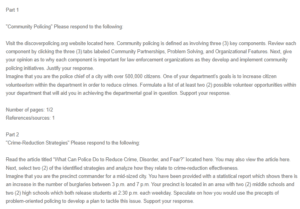Community Policing and Crime-Reduction Strategies
Community Policing
Community policing involves three major components: problem-solving, community partnerships, and implementation of organizational features of community policing (Somerville, 2009). In problem-solving, officers are urged to identify problems proactively, come up with innovative responses, and conduct result evaluations. Fighting crimes happen to be more proactive than reactive. Community partnerships, on the other hand, are where interactive partnerships are encouraged by community policing between agencies of law enforcement, officers, and community members. When connections are established within the community, the police are better empowered to solve problems regarding safety. Finally, various organizational characteristics and features have helped to support partnerships in community policing and problem-solving efforts. This way, officers are empowered to interact with the community members on a daily basis. Do you need help with your assignment ? Get in touch with us at eminencepapers.com.
The police department can establish a citizen volunteer program to increase citizen volunteerism (Choudhury, 2010). This program enhances community outreach and customer service. It helps in the improvement of life quality by strengthening the relationship between the citizens and the police, bringing advocacy and innovation, and providing the opportunity for the participation of citizens in the police department. Another way to encourage citizen volunteerism is to encourage participation in the Citizen Police Academy which enables residents to learn about the mission and values of law enforcement agencies. This way, they better understand the various aspects of the job.
Crime Reduction Strategies
Increasing the size of police agencies
According to some case studies, police absence will likely result in an increase in crimes (Gill, 2014). While some reviews are not that strong, their conclusions tend to be consistent. However, it is not clear whether an increase in the number of agencies will result in a reduction in disorder, crime, or fear.
Random patrols across every part of the community
Random preventive patrols by the police have continued to be among the most persistent standards of police practice (Gill, 2014). But the evidence that supports this practice is not strong either, and the research reviewed are over twenty-five years old.
To tackle the issue of burglaries in town, one precept of the POP model can be effective in developing the plan, and that is the fact that expectation of the program should be realistic in that they are not expected to curb the issue in a short period to ensure the safety of the residents. The police can collaborate with outside CJA to curb the burglary issue which will take time.
References
Somerville, P. (2009). Understanding community policing. Policing: an international journal of police strategies & management, 32(2), 261-277.
Choudhury, E. (2010). Attracting and managing volunteers in local government. Journal of Management Development, 29(6), 592-603.
Gill, C., Weisburd, D., Telep, C. W., Vitter, Z., & Bennett, T. (2014). Community-oriented policing to reduce crime, disorder, and fear and increase satisfaction and legitimacy among citizens: A systematic review. Journal of Experimental Criminology, 10(4), 399-428.
ORDER A PLAGIARISM-FREE PAPER HERE
We’ll write everything from scratch
Question

Community Policing and Crime-Reduction Strategies
Part 1
“Community Policing” Please respond to the following:
Visit the discoverpolicing.org website located here. Community policing is defined as involving three (3) key components. Review each component by clicking the three (3) tabs labeled Community Partnerships, Problem Solving, and Organizational Features. Next, give your opinion as to why each component is important for law enforcement organizations as they develop and implement community policing initiatives. Justify your response.
Imagine that you are the police chief of a city with over 500,000 citizens. One of your department’s goals is to increase citizen volunteerism within the department in order to reduce crimes. Formulate a list of at least two (2) possible volunteer opportunities within your department that will aid you in achieving the departmental goal in question. Support your response.
Number of pages: 1/2
References/sources: 1
Part 2
“Crime-Reduction Strategies” Please respond to the following:
Read the article titled “What Can Police Do to Reduce Crime, Disorder, and Fear?” located here. You may also view the article here. Next, select two (2) of the identified strategies and analyze how they relate to crime-reduction effectiveness.
Imagine that you are the precinct commander for a mid-sized city. You have been provided with a statistical report which shows there is an increase in the number of burglaries between 3 p.m. and 7 p.m. Your precinct is located in an area with two (2) middle schools and two (2) high schools which both release students at 2:30 p.m. each weekday. Speculate on how you would use the precepts of problem-oriented policing to develop a plan to tackle this issue. Support your response.

